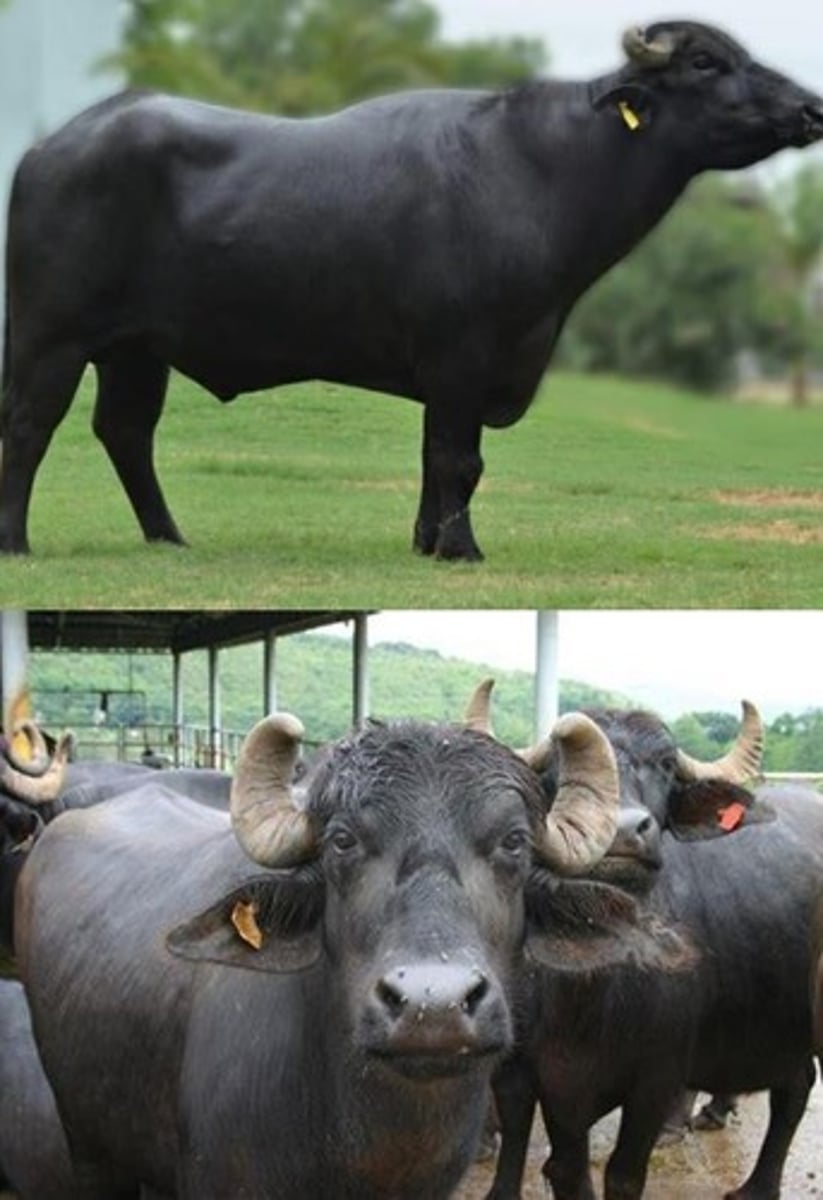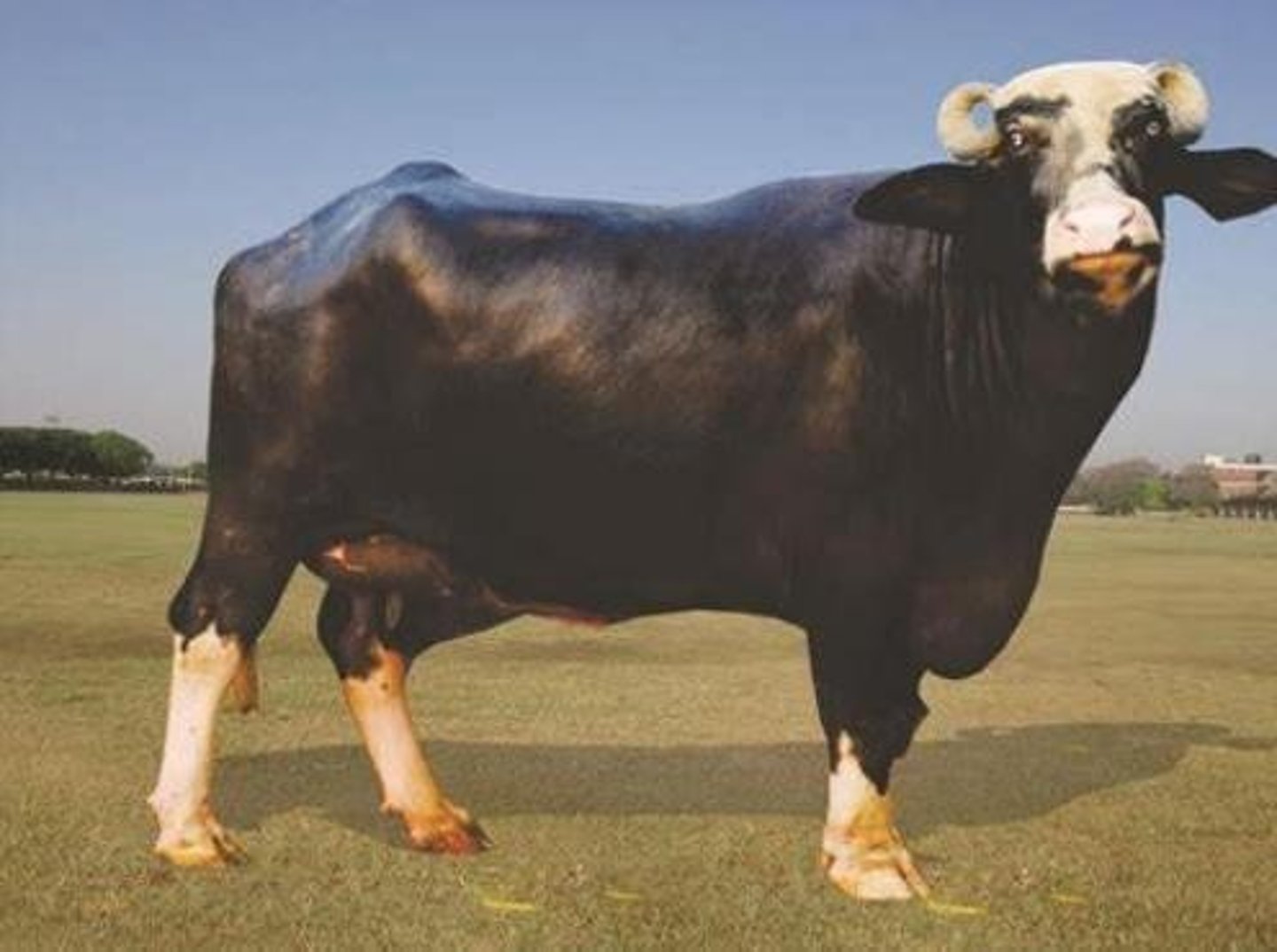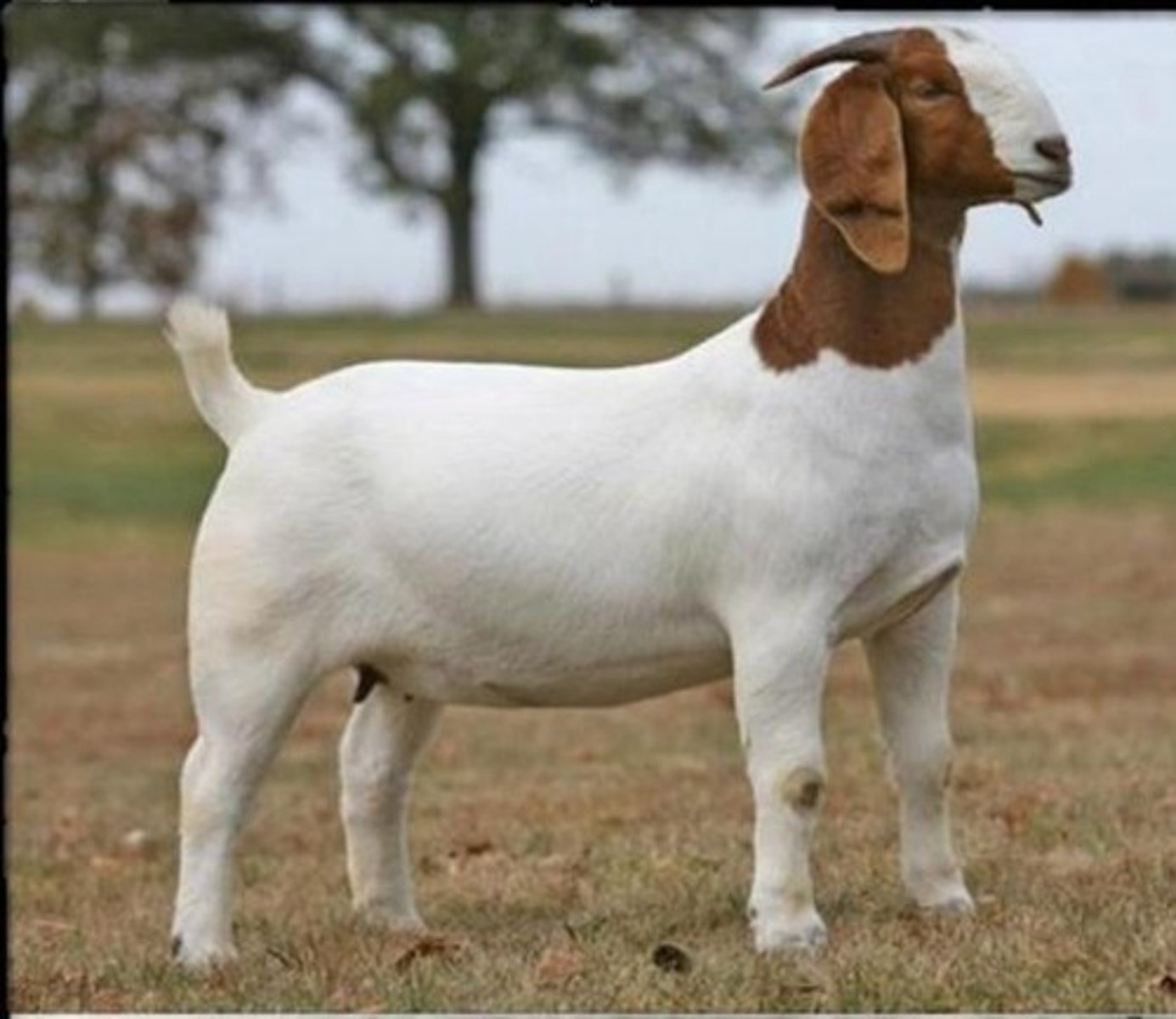Overview of Water Buffalo and Goat Breeds
1/91
There's no tags or description
Looks like no tags are added yet.
Name | Mastery | Learn | Test | Matching | Spaced |
|---|
No study sessions yet.
92 Terms
Water buffalo (Bubalus bubalis)
Large domestic buffalo species found across India to Vietnam, Sri Lanka, Borneo, and Peninsular Malaysia.

Riverine Buffalo
Mainly for milk, sometimes also for meat; chromosome number: 2n = 50; locations: India, Pakistan, Egypt, Europe.

MURRAH (River Type)
Jet black, soft and fine skin; high milk producer: 14-15 L/day, can reach 31.5 kg; elite Murrah can exceed 18 L/day.
NILI-RAVI (River Type)
Black body; large: males ~800 kg, females ~525 kg; distinct white markings on forehead, face, legs, muzzle, and tail switch.
PANDHARPURI (River Type)
Black with some white on forehead, legs, tail switch; medium size: ~450-470 kg; very long, sword-like horns (up to 1.5 m).
JAFFARABADI
Mostly black; some have gray or white markings; largest/heaviest Indian buffalo breed; milk yield: ~2238.7 kg/lactation.

SURTI (River Type)
Rusty brown to silver-grey; high milk fat content: 8-12%; milk yield: 900-1300 kg/lactation; calving age: 40-50 months.
Swamp Buffalo
Mainly for draft and meat; chromosome number: 2n = 48; locations: Southeast Asia, China, Australia.
PHILIPPINE CARABAO (Swamp Type)
Dark gray to black; used mainly for draft and meat, not milk; some albinoids (~3% of population).
VIETNAMESE BUFFALO
Species: Bubalus bubalis carabanesis; color: dark gray to black; used mainly for draft and meat.
THAILAND BUFFALO
Similar to other swamp buffalo; used mainly for draft and meat.
CHINESE BUFFALO
Used mainly for draft and meat; characteristics similar to other swamp buffalo.
CAMBODIAN BUFFALO
Used mainly for draft and meat; characteristics similar to other swamp buffalo.
Dairy breeds
Goat breeds recognized for high milk production.
Mohair (fiber) breeds
Goat breeds recognized for fiber production.
Meat breeds
Goat breeds recognized for meat production.
Alpine Dairy Goat
Known for being hardy and adaptable to various climates; excellent milkers with large, well-shaped udders.
Cou Blanc
White neck color in Alpine goats.
Cou Clair
Clear neck color in Alpine goats.
Cou Noir
Black neck color in Alpine goats.
Sundgau
Black with white markings in Alpine goats.
Pied
Spotted or mottled color in Alpine goats.
Chamoisee
Brown or bay color in Alpine goats.
Two-tone Chamoisee
Two-tone color variation in Alpine goats.
Broken Chamoisee
Broken color pattern in Alpine goats.
Broken cou blanc
Broken pattern
LA MANCHA
Developed in the U.S. by crossing short-eared Spanish goats with purebred breeds.
LA MANCHA Color
Any color.
LA MANCHA Hair
Short-haired.
LA MANCHA Face
Straight.
LA MANCHA Unique Feature
Very short ears, two types: Gopher ear - ≤ 1 inch, minimal.
ALPINE (French-Alpine Goat)
Origin: France, from Swiss foundation stock.
ALPINE Other Names
Includes French Alpine (most popular), British Alpine, Rock Alpine, Swiss Alpine.
ALPINE Color
Varies widely — from pure white to black, with many color patterns.
ALPINE Ears
Erect.
ALPINE Hair
Short-haired.
ALPINE Other Features
Cartilage, tip may turn up/down; Elf ear - ≤ 2 inches, slightly more cartilage.
ALPINE Traits
Extremely hardy and adapted to adverse conditions; produces milk high in fat content.
SAANEN
Origin: Saanen Valley, Switzerland.
SAANEN Color
Pure white preferred; other markings reduce value.
SAANEN Hair
Long or short.
SAANEN Ears
Erect and alert.
SAANEN Size
Largest among Swiss breeds.
NUBIAN
Origin: Africa.
NUBIAN Color
Any color or mix (common: black, gray, cream, white, tan, reddish brown).
NUBIAN Coat
Short and sleek.
NUBIAN Ears
Long, wide, pendulous (droopy) — extend 1 inch beyond the muzzle.
NUBIAN Head
Distinct Roman nose (strongly convex facial profile).
NUBIAN Traits
Very popular dairy breed; produces large quantities of milk; milk has lower fat content compared to other breeds.
TOGGENBURG
Origin: Switzerland; first imported to the U.S. in 1893.
TOGGENBURG Color
Light fawn to dark chocolate.
OBERHASLI
Origin: Switzerland; now also found in Europe and the U.S.
OBERHASLI Size
Medium.
OBERHASLI Ears
Erect, pointing forward, giving an alert appearance.
OBERHASLI Color
Bay (light to deep red).
SPANISH GOATS
Origin: Descendant of various milk breeds (mongrel type).
SPANISH GOATS Other Names
Also called brush goat or meat goat.
SPANISH GOATS Primary Use
Meat production; also used for milk.
BOER
Appearance: White body, brown head; long, droopy ears.
BOER Origin
Eastern Cape, South Africa, early 1900s.
MYOTONIC (WOODEN LEG)
Appearance: Black/white or mixed; upright ears.
MYOTONIC Unique Trait
When frightened or excited, muscles stiffen, causing them to 'faint' and fall over briefly.
PHILIPPINE GOAT
Two varieties of Philippine goats raised for meat production: Coarse haired type - is cream, tan, or light brown and usually polled; Fine hair variety - is black or brown and may have a white belt, usually horned.
ANGORA
Origin: Angora Province, Turkey - mountainous, dry climate with extreme temperatures.
ANGORA Color
White.
ANGORA Weight
Bucks: 125-175 lbs (56.7-79.4 kg); Does: 80-90 lbs (36.3-40.8 kg).
CASHMERE
Appearance: Various colors; upright ears, soft fluffy coat (not a breed but a type).
Care
Easy to raise, healthy, requires minimal care
Fencing
Not jumpers; can be contained with standard sheep fencing
Shelter
Needs only minimal shelter due to their insulating dual coat
Coat Traits
Dual fiber: soft cashmere + coarse guard hair = excellent insulation
Births
Single births more common than twins
Mohair Types
C Type - Ringlet mohair: tight curls, finest quality
Origin
Denmark
Use
Bred for pork production
Reputation
Known for prolific breeding and excellent mothering ability
Color
White
Build
Medium to large, long-bodied, with 16-17 ribs (lean physique)
Ears
Large, heavy, and drooping
Other Features
Fine hair, long snout
Taxonomical Classification
Kingdom: Animalia, Sub-Kingdom: Eumetazoa, Phylum: Chordata, Sub-Phylum: Vertebrata, Super-Class: Gnathostomata, Class: Mammalia, Genus: Sus, Species: scrofa or domestica
Maternal Breeds
Known for large litters and replacement females
Terminal Breeds
Known for growth and carcass quality. Used in terminal crosses
Landrace
Origin: Yorkshire, England; developed by crossing Yorkshire and White Leicester breeds
Berkshire
Origin: England; Use: Known for premium-quality pork - juicy, tender, flavorful
Duroc
Origin: USA; Use: Known for excellent muscle quality and low stress mortality; widely used in crossbreeding programs
Poland China
Origin: Ohio, USA, early 1800s; Use: Valued for meat production
Pietrain
Origin: Pietrain, Belgium; Use: Primarily for meat production
Hampshire
Origin: USA; Use: Valued for lean muscle, high carcass quality, low back fat, and large loin
Philippine Native Pig
Appearance: Black or brown, small to medium body, erect or semi-erect ears.
Native Pig Breeds
Examples: Ilocos, Jala - jala, Bekjala, Diani, Kaman, Koronadel, Libtong
Hybrid/Synthetic Breeds
Examples: Hypor, Babcock, Dalland/Topigs, Seghers